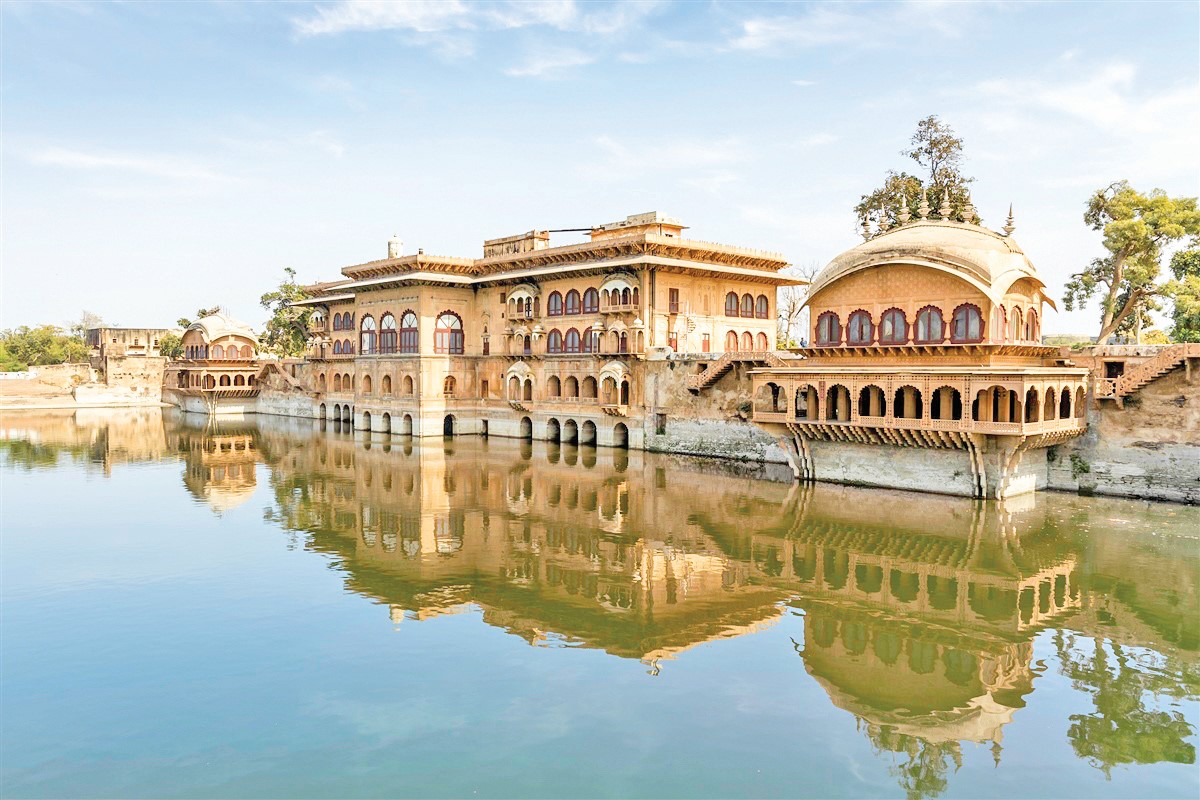Deeg Palace is an 18th century paradise consisting of the combination of both engineering and enchantment, where fountains showcase the victory of the region and where a desert ruler once captured the very essence of rain.
The Warriors Who Built Paradise
When Maharaja Suraj Mal rode into Delhi in the mid-18th century, he didn’t just dream of conquest; rather, he dreamed of transplanting beauty itself. As his armies dismantled an entire marble building from the Red Fort, numbering each piece like a giant puzzle, he was already envisioning a summer retreat that would challenge nature’s harsh rules in his kingdom of Deeg.
The year was 1772, and the Jat ruler’s ambition would birth more than just a palace; it would create an oasis that still confounds visitors with its ingenuity. Rising from strategic foundations that once faced down armies of 8,000 men, Deeg Palace emerged as a testament to the fusion of military might and aesthetic delight.
In defiance of its arid surroundings, the palace complex embraces the Mughal concept of Charbagh with an audacity that would have made the emperors of Agra smile. Two massive water tanks, Gopal Sagar and Rup Sagar, flank the grounds like liquid sentinels, their surfaces reflecting sky and stone in an endless dance.
Between these aquatic giants, geometric flowerbeds paint the ground in patterns that change with seasons. The quadrangle design doesn’t just please the eye; it creates its own microclimate, where careful placement of shrubs and trees transforms hot desert winds into cool whispers through shaded walkways.
The Palace That Makes Its Own Weather
But it’s in the Keshav Bhawan, the legendary monsoon pavilion, where Deeg Palace reveals its most magical secret. This single-story baradari, perched on an octagonal base beside the Rup Sagar tank, houses an engineering feat that would impress modern architects.
Five graceful arches along each side frame a spectacle that seems to bend nature itself. An intricate network of fountains, hundreds of them, springs to life through a complex system once powered by bullocks and leather buckets. Water jets hidden within the walls create a crystalline curtain, while overhead, an ingenious mechanism produces the sound of thunder.
Symphony in Water and Stone
The thunder effect, achieved through hundreds of metal balls set rolling by water pressure in rooftop channels, transforms the pavilion into a theatrical experience. During festivals like Holi, the fountains would spray rainbow colors, created by cloth pouches of organic dyes strategically placed in the reservoir walls.
This wasn’t mere entertainment; it was environmental engineering at its most creative. In a region where summer temperatures soar, this artificial monsoon provided both practical relief and poetic beauty, turning the pavilion into a multi-sensory refuge from the desert heat.
Secrets Within Secrets
Beyond its famous fountains, Deeg Palace harbors countless mysteries. The king’s bedroom contains a massive black granite bed with a dark past; it once served as a platform for Parsi death rites. Such contradictions abound throughout the complex, where military fortifications cradle gardens of incredible delicacy.
The palace’s design reflects a unique amalgamation of Mughal grandeur and Rajput pragmatism. War-tested walls and deep moats encircle spaces of profound beauty, creating a sanctuary where art and power coexist in perfect balance.
A Living Calendar of Blooms
February and March transform the palace into a painter’s dream. Roses burst forth in carefully maintained parterres, while flowering bushes add their colors to the symphony. The soft green canopy of mango, jaman, amalaka, and neem trees provides shelter before the harsh winds of Indian spring arrive.
This careful orchestration of natural elements reveals the sophisticated understanding of seasonal rhythms that went into the palace’s design. Every tree, every fountain, and every flower bed was positioned to maximize both beauty and practical comfort.
Legacy of the Jat Kings
Before Bharatpur rose to prominence, Deeg was the capital of the Jat kingdom. The palace complex, begun by Badan Singh in 1721 and gloriously expanded by his son Suraj Mal, stands as the only Hindu-style palace in North India. Its unique architecture tells the story of a dynasty that dared to challenge Mughal might while embracing Mughal aesthetics.
The palace’s strategic position near Agra turned it into both a military stronghold and a cultural bridge. Contemporary accounts compare its beauty and commercial importance to Delhi itself, marking it as “first class among the protected places of fortifications of India.”
Preserving Paradise
Today, the palace complex stands as a carefully preserved monument, its fountains still capable of creating their famous monsoon magic. Though it ceased to be a royal residence in the early 1970s, its engineering systems continue to amaze visitors, while its gardens maintain their centuries-old rhythm of seasonal transformations.
Conservation efforts focus not just on maintaining the structures but on preserving the complex hydraulic systems that make Deeg unique. Modern caretakers face the challenge of protecting both the palace’s physical fabric and the traditional knowledge that keeps its fountains flowing.
Time Travel Through Five Senses
A visit to Deeg Palace is an immersive time travel experience for all senses. The thunder of fountains, the play of light on water, the aroma of seasonal blossoms, and the cold touch of water-laden air all contribute to an experience that goes beyond normal history tourism.
Deeg, with its strategic location four hours from Delhi, two from Agra, and one from Mathura, continues to serve as a crossroads of history, architecture, and technical innovation. In an age of digital miracles, its capacity to generate fake weather using just mechanical methods is a statement to human creativity.
As the sun sets beyond Gopal Sagar, sending long shadows across centuries-old gardens, Deeg Palace reminds us that genuine luxury is not about ostentation but about achieving harmony between human aspiration and natural forces. Every fountain jet and thunder roll in this desert oasis reflects the vision of kings and queens who dared to dream of paradise on Rajasthan’s dunes.









